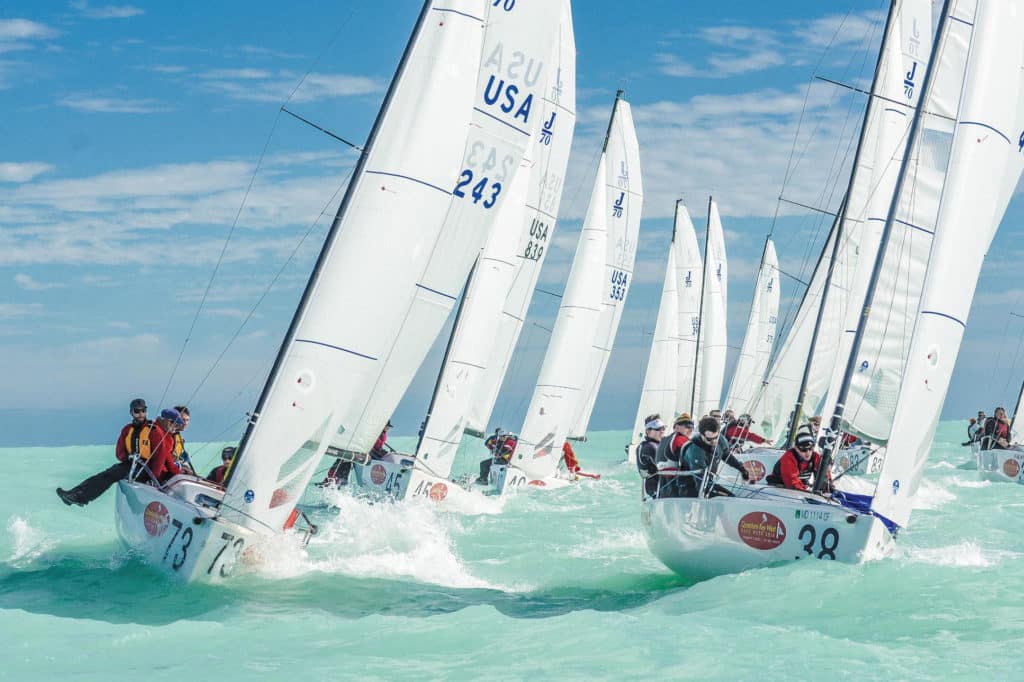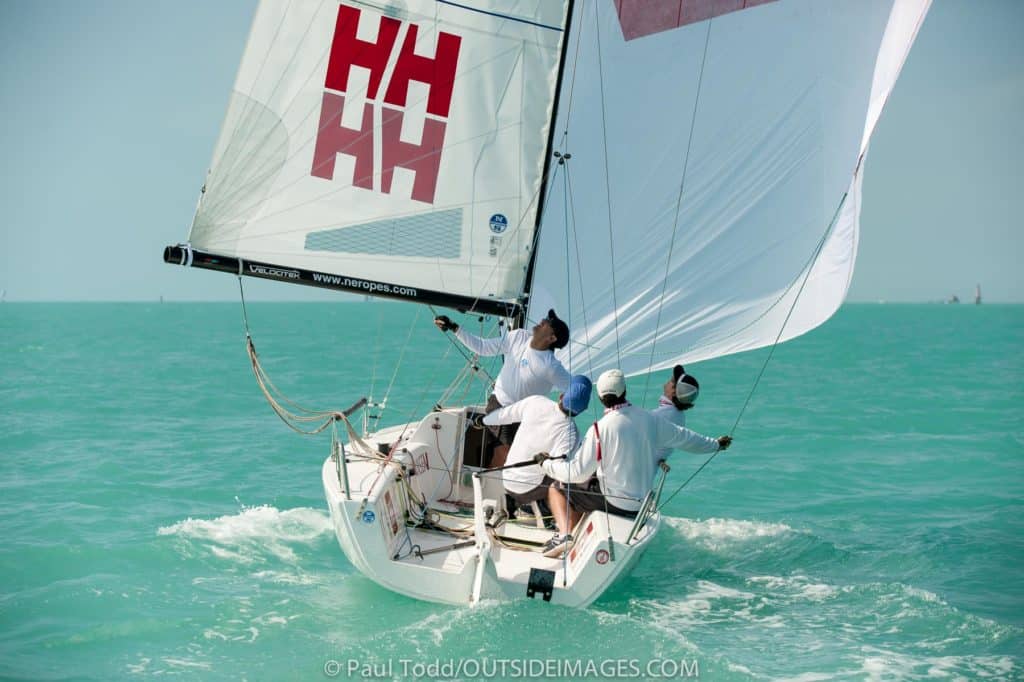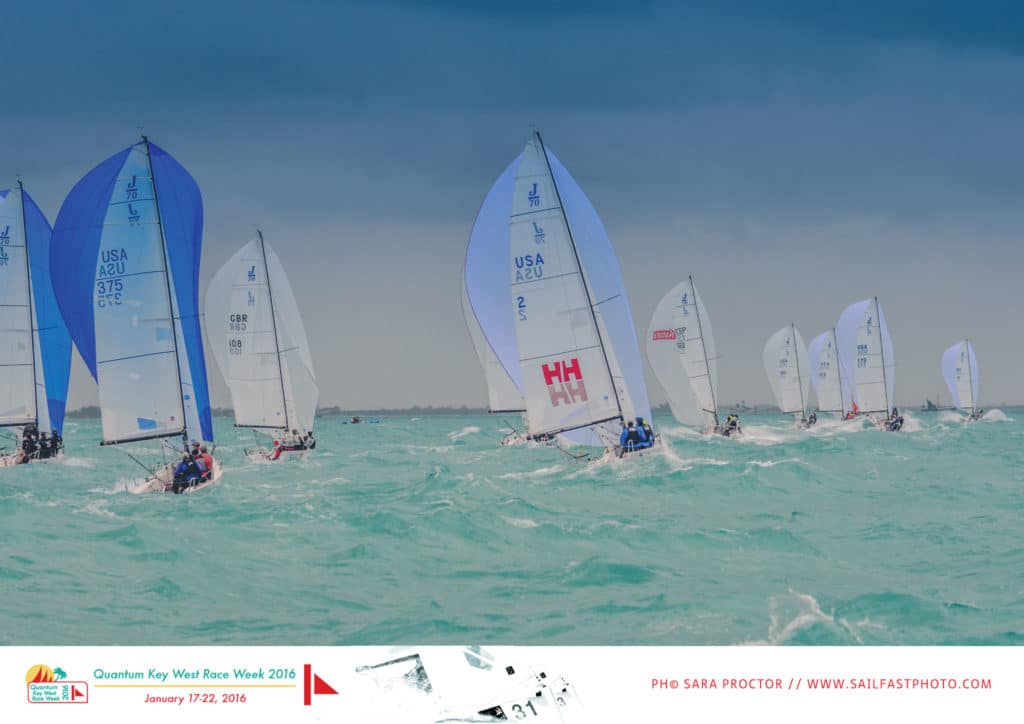Friday, Jan. 22
It’s Day 5 at Key West Race Week and the forecast is for breeze and rain, increasing to more breeze and more rain. Awesome! Every sailboat is more fun to sail when the breeze is up and there will be screaming downwind legs. Even with the rain likely all day, we were excited to sail in some winds over 20 knots.
So, it’s going to be a big breeze day: how should we approach the conditions? Some may think being conservative might be the safe play in higher winds to avoid a big mistake or a downwind wipeout. However, being aggressive and pushing the limit is a much better strategy. Sailing the boat hard and closer to the edge will normally mean sailing at higher boatspeeds through the water and the faster a boat sails, the more stable it becomes.
Sailing at full speed or planing allows for a more efficient transfer from increased wind pressure to speed through the water. For a J/70, getting a big gust while already sailing at over 10 knots will accelerate the boat even faster. On the other hand, when a boat is sailing more slowly the added pressure in the rig from a gust has a greater tendency to force the boat over since accelerating to a higher speed cannot happen fast enough.
On this final day of KWRW, one race was completed in 18-25 knots of wind before the wind and rain really kicked in and the fleet was sent home. Unfortunately for us, we had a couple of missteps and fell back early in the race forcing us to catch up to the leaders. We were able to come back to a good finish in large part because we kept pushing our boat and ourselves hard until the end.
Experience has taught me that sailing in 20-plus knots is challenging for all boats. At some point, every boat or team has a problem dealing with stronger winds and distance can be made or lost much more quickly at the higher boatspeeds. As a result, fleets of boats racing in big breezes often get spread out with much larger gaps between the boats because small differences in speed become larger differences at higher speeds.
The first step in getting better and more comfortable in strong winds is to get out on the water when you have those conditions. You can’t get better at anything with out doing it and sailing in big breeze is no exception. Next, attack the racecourse when the breeze is up. Again, being aggressive with the wind and waves is by far the best way to maintain control of the boat. Over time, pushing the boat and crew to the limit will create the most exciting sailing moments you will have on the water, and maybe some stories you will tell your grandkids!
My one last piece of insight for racing in winds over 20 knots is…do not give up! Even if you make a mistake and lose distance on the fleet, in higher winds other boats will have struggles too and there will be opportunities to make up time and distance. Keep pushing hard and the faster you go the faster you can catch the boats ahead.
Thursday, Jan. 21
There are a lot of regattas to sail, but one of the first each year, and maybe the most enjoyable, is a race week held in the Southern most location of the USA, Key West. With the large majority of regattas having one, two, or occasionally three days of racing, Key West Race Week is exactly what the name suggests, a five-day week of racing in the Florida Keys. The weeklong format is certainly a marathon and not a sprint for the sailors as well as the regatta organizers. For competitors that do not commonly sail in events longer than three days, maintaining focus and intensity over a weeklong regatta can be a challenge.
An added curveball for the sailors at KWRW is the shore side and evening activities on the island. There’s no lack of opportunities to have a “big night” every night in Key West. As the more seasoned sailors have learned, through experience probably, the more you do at night, the less you are likely capable of during the day. For me at least, the five days of KWRW are hard enough without adding extra nightlife to the agenda, and I know for sure the results of KWRW have surely been affected during the wee hours of the night on Duval Street or the Green Parrot.
As I write this, after the fourth day, it has already been a long week to this point. This year we lost one day to stormy conditions so organizers have made up for that loss with extra races on the other sailing days. Three races on each of the other three race days have made for long days and tired nights. After the evening regatta activities, we have just enough energy for dinner before heading back to our place to get some rest until doing it all again the next day
For our team, trying to finish on the podium is the goal and for a long regatta like KWRW our conservative approach can be summed up in one simple phrase, “you can’t win the regatta in one day, but you can easily lose it.” If we have one day of the regatta where we are unable to sail at our best, it might cost us any chance at a top finish. In reality, it is hard enough to do well against the caliber of sailors at Key West without making the task more difficult by wearing yourself out all day and then all night.
In the end, every team and every sailor has to make the choice that is best for them. KWRW will easily be able to accommodate the sailors that want to sail in great conditions against some of the best competitors while at the same time providing one of the best after sailing parties every night.

Monday, Jan. 19 Bang! As the spinnaker is hoisted, the halyard cleat explodes and separates from the mast. Now what? We were rounding the first windward mark offset in the second race of Day 1 at the 2016 Key West Race Week when we instantly had no way of cleating the spinnaker halyard. Something had to be done as other boats around us were filling their spinnakers and beginning to plane downwind toward the leeward gate.
Before any regatta, boat preparation is a key element to competitive success. Making sure sails, lines and fittings are in the best possible working order allows the crew to push the boat and equipment hard in each race during the regatta. What if something breaks? Breakdowns during a race are one of the more challenging situations in any sailboat race. Again, preparation can be critical to whether a breakdown is fixable or race ending.
Sailors with experience sailing a specific boat become familiar with what maintenance issues are most common for that boat. Knowing what parts of the boat are most likely to fail helps a crew focus their attention on the maintenance of those areas before and during an event. That knowledge is also helpful when deciding which spare parts might be carried on board to deal with unfortunate equipment failures. Along with specific spares for the boat, extra line, shackles, tape and tools are always a good idea to include onboard while racing.
Another aspect of performing repairs on the water is the “jury rig” or improvised rigging solution. In my experience, when a breakdown occurs during a race, after ensuring the boat and crew’s safety, there are two directions to focus repair attention. First, stop the bleeding and continue to keep the boat racing toward the finish line. Second, find the best solution that will allow the broken part to function as close to normal as possible. This step may take a few minutes to address in order to come up with the final solution and should not be rushed if the boat is already continuing in the race.
After our spinnaker halyard cleat failed we first tried to find a place to secure the halyard and continue to sail downwind. Our initial solution was to take the halyard from the mast and use the jib furler cleat. While this was a good solution to immediately continue in the race, the angle of the halyard was against the boom and was preventing the boat from jibing. As two of the crew continued to sail the boat, the others looked for another way to secure the halyard that would allow us to jibe toward the leeward mark.
After some discussion, the halyard was led around the front of the mast and tied off on the main halyard cleat for jury rig 2.0. The halyard in this position allowed us to jibe and continue toward the leeward mark and finish. After our jibe, another possible solution was suggested which became our best and final remedy for the broken equipment. We were able to un-rig the starboard half of our boom vang and use the block and cleat on that side to lead and cleat our spinnaker halyard. This solution was perfect for the situation because the halyard was able to function very close to normal and the only rigging we had to give up was the starboard side adjustment of the boom vang.
With our breakdown in the beginning of the second race and our jury rig giving us full functionality of the spinnaker halyard, we were able to stay in the race and even catch a few boats before the finish. Since our race committee decided to run a third race of the day, we had no trouble sailing the entire race with our newly designed halyard. In fact, the temporary rigging change worked so well, we sailed all the way to the front winning the final race of the day!

J/70 wing technique
Sunday, Jan. 16 There’s a new trend in the J/70 class, with and more of the fleet sailing straight downwind, wing-on-wing, with the gennaker and mainsail on opposite sides of the boat. At first, the sight of these sportboats attempting to sail straight downwind seems counterintuitive, but many teams seemed to be making it work to their advantage. It’s not really a big surprise that there’s something to gain from sailing the straightest course to the mark while other boats sail traditionally higher sailing angles and longer courses.
While sailing in and watching the fleet at Davis Island earlier this winter, often 30 percent of the boats might be sailing wing-on-wing on a given downwind run, making the fleet appear more symmetric than asymmetric. This trend has resulted in many teams practicing and perfecting the specifics of the wing-on-wing sail handling and trim. However, even with the teams have it dialed, the question remains whether this unorthodox downwind mode really works and when it’s better to keep this mode in the bag.
Leading up to Key West Race Week, J/70 teams were busy fine-tuning rig tune, sail trim and boathandling, which includes adding the wing-on-wing downwind mode. We’ve practiced sailing wing-on-wing in different wind conditions and sea states and have determined the maneuver is something to be used sparingly. While it can provide an advantage in certain conditions and situations, when used at the wrong time it is easy to lose distance to other boats in the fleet.
So, when is the best time to sail wing-on-wing? In general terms, the maneuver works best for the J/70 when the boat is fully powered while sailing a normal downwind angle and not yet able to get up on a plane. If the wind isn’t strong enough to keep the boat and sails fully powered on a normal downwind angle, the gennaker will not have enough power or stability to remain full when held out away from the boat on the wing. In windier conditions, when the J/70 can maintain a constant plane downwind, the higher boat speeds while the boat is planing seem to provide better VMG than sailing straight downwind at slower speeds.
One final check to see if sailing wing-on-wing is the best mode for the conditions is the comparative speed of the boat on and off the wing. If the boat’s speed while sailing wing-on-wing is similar to the boat’s speed while sailing a normal downwind angle, sailing on the wing will save distance and likely be the better mode. Anytime the boat slows down significantly when attempting to sail more downwind and wing-on-wing, the normal mode and faster speed will likely be best.











